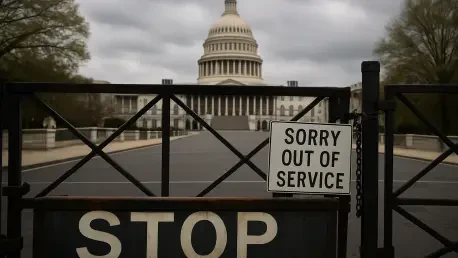Unraveling Healthcare Enrollment Challenges in a Federal Standoff
Amid a government shutdown stretching into its fourth week, the Centers for Medicare & Medicaid Services (CMS) confronts a pivotal challenge in sustaining healthcare enrollment for millions of Americans, especially with critical open enrollment periods for Medicare and Affordable Care Act (ACA) plans in full swing. The agency’s decision to recall approximately 3,000 furloughed staffers signals a desperate bid to maintain market stability. This analysis delves into the intricate dynamics of CMS’s operational maneuvers, the political gridlock threatening ACA subsidies, and the broader implications for healthcare access. By examining current trends, consumer impacts, and future projections, this exploration aims to illuminate the resilience and vulnerabilities within the healthcare enrollment market, offering stakeholders a clearer perspective on navigating these turbulent times.
Dissecting Market Trends and Operational Responses
Enrollment Under Pressure: CMS’s Tactical Recall
The healthcare enrollment market faces unprecedented strain as the government shutdown disrupts federal operations. CMS, tasked with overseeing Medicare and Medicaid, has taken a significant step by temporarily recalling furloughed employees to support the ongoing enrollment seasons. With Medicare open enrollment active since mid-October and ACA enrollment commencing at the start of November, the timing of this recall is critical. Funded through user fees from data-sharing with researchers, this move ensures that essential support systems remain operational during peak demand. However, the temporary nature of this solution raises questions about sustained service delivery if the shutdown persists.
Funding Crisis Impact: Delays and Market Disruptions
Beyond immediate staffing solutions, the shutdown has introduced broader disruptions to the healthcare market. Agency communications, rulemaking, and oversight activities have slowed, creating bottlenecks that could affect enrollment efficiency. Historical data from past shutdowns, such as those experienced over a decade ago, indicate that prolonged funding lapses often lead to cascading delays in consumer support and plan updates. While mandatory programs like Medicare and Medicaid are shielded from direct cuts due to protected funding, the current situation—among the longest shutdowns in recent memory—amplifies risks of indirect market impacts, particularly for time-sensitive enrollment processes.
Consumer Sentiment: Navigating Uncertainty in Plan Selection
Consumer behavior in the healthcare market reflects growing uncertainty as individuals grapple with incomplete information during enrollment. Many browsing state marketplaces report confusion over potential costs, exacerbated by the federal Healthcare.gov website’s delay in displaying updated plan prices for the coming year. This lack of transparency hinders informed decision-making, a critical factor in maintaining enrollment numbers. Market analysts note that such disruptions disproportionately affect vulnerable populations reliant on timely access to affordable plans, underscoring the urgent need for operational clarity as deadlines loom.
Political Gridlock and Subsidy Expiration: A Market Threat
ACA Subsidies at Risk: Premium Shocks on the Horizon
A looming threat to the healthcare enrollment market lies in the political impasse over enhanced ACA subsidies, initially introduced as a relief measure during the pandemic. Set to expire at the end of this year, these subsidies have driven record enrollment by making plans more affordable for low- and middle-income individuals. Projections suggest that their lapse could result in premium hikes exceeding 100% for 4 to 5 million enrollees, potentially pricing many out of coverage. This affordability crisis poses a direct challenge to market stability, with significant implications for participation rates in ACA exchanges.
Partisan Standoff: Delaying Resolution and Market Planning
The political divide over subsidy extensions further complicates market dynamics. Democratic leaders advocate for extending these cost-saving measures as a prerequisite for supporting a broader funding bill to end the shutdown. Conversely, Republican counterparts argue for postponing discussions until government operations resume fully. This deadlock leaves insurers and state regulators with tight timelines to adjust plans for the 2026 cycle, even if a last-minute agreement emerges. The resulting uncertainty hampers strategic planning, creating a ripple effect across the healthcare insurance market.
Regional Variations: Disparate Impacts Across Markets
Market impacts from subsidy expiration are unlikely to be uniform, with regional differences playing a significant role. States with robust local marketplaces may mitigate some affordability challenges through tailored programs, while others heavily dependent on federal support could face steeper enrollment declines. Analysts highlight that rural and underserved areas are particularly at risk of reduced access if premiums spike. This uneven landscape underscores the complexity of predicting market outcomes, as local policies and economic conditions intersect with federal inaction to shape consumer experiences.
Future Projections: Healthcare Access in a Volatile Landscape
Enrollment Forecasts: Balancing Optimism and Risk
Looking toward the near future, the healthcare enrollment market stands at a crossroads. If ACA subsidies lapse without renewal, projections indicate a potential drop in enrollment numbers, reversing gains achieved through recent affordability measures. Conversely, a resolution to the political standoff could stabilize participation, particularly if paired with enhanced digital tools to streamline enrollment. CMS’s current efforts to maintain operational continuity through staff recalls offer a buffer, but long-term market health hinges on systemic funding solutions rather than temporary fixes.
Technological Innovations: A Potential Market Stabilizer
Emerging technological solutions present a glimmer of hope for mitigating market disruptions. Streamlined digital platforms for enrollment and consumer support could alleviate some pressures caused by staffing shortages and communication delays. However, implementation of such innovations is constrained by the ongoing funding crisis, limiting their immediate impact. Over the next few years, from this year to 2027, investment in technology may become a critical differentiator for maintaining market access, provided fiscal barriers are addressed through policy action.
Policy Shifts: Anticipating Regulatory Changes
Regulatory uncertainty adds another layer of complexity to market projections. Potential shifts in federal priorities, including concerns over additional program cuts or layoffs under current administrative policies, could reshape CMS’s capacity to support enrollment. Analysts caution that without bipartisan commitment to healthcare funding, disparities in access may widen, particularly for low-income households. The interplay of policy decisions and market responses will likely define the trajectory of healthcare affordability and participation in the coming cycles.
Reflecting on Market Insights and Strategic Pathways
Reflecting on the analysis, the past months have revealed both the resilience and fragility of the healthcare enrollment market amid a government shutdown. CMS’s tactical recall of furloughed staff highlighted a commitment to operational stability during critical periods, yet the looming expiration of ACA subsidies underscored deeper systemic risks that threaten affordability. Moving forward, stakeholders must prioritize advocacy for subsidy extensions to prevent premium shocks, while insurers and regulators should develop contingency plans for varying market scenarios. Consumers, meanwhile, benefit from staying informed about state-specific resources to navigate enrollment uncertainties. Ultimately, the path ahead demands collaborative efforts to secure funding resolutions, ensuring that technological advancements and policy reforms align to safeguard healthcare access for millions.









